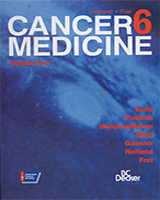By agreement with the publisher, this book is accessible by the search feature, but cannot be browsed.
NCBI Bookshelf. A service of the National Library of Medicine, National Institutes of Health.
Kufe DW, Pollock RE, Weichselbaum RR, et al., editors. Holland-Frei Cancer Medicine. 6th edition. Hamilton (ON): BC Decker; 2003.

Holland-Frei Cancer Medicine. 6th edition.
Show detailsDevelopment of pyrimidine and purine analogs as potential antineoplastic agents evolved from an early presumption that nucleic acids are involved in growth control. Among the first analogs produced and tested for biologic activity were the 5-halogenated pyrimidines: 5-chloro-, 5-bromo-, and 5-iodouracil. Although in original concept these agents were targeted toward the malaria parasite, G. H. Hitchings and his colleague G. B. Elion recognized that these compounds might be valuable in the treatment of cancer, which was correctly perceived as a disease of uncontrolled growth.1,2 These early studies focused primarily on the incorporation of analog nucleic acid bases into ribonucleic acid (RNA) or deoxyribonucleic acid (DNA) of bacteria species.3 Concurrent studies on the metabolic activation of these heterocyclic analogs and their biochemical targets for growth inhibition, as well as the study of resistance to them, afforded many new insights into the intermediary metabolism responsible for the synthesis of DNA and RNA precursors.4 Subsequently, it was recognized that control of these biosynthetic pathways afforded additional targets for therapeutic intervention.
Further development of these analogs was stimulated by the demonstration of quantitative, but not qualitative, differences in the activity of these pathways between normal versus neoplastic tissue. It was also realized that rapid catabolism of these agents to inactive compounds could severely limit anabolic conversion to fraudulent nucleotides. This, in itself, affords targets for the modulation of cytotoxic activity on a tissue-specific basis.
A virtually complete understanding of enzymes involved in the biosynthesis of purine and pyrimidine nucleotide precursors of RNA and DNA is now at hand.5,6 This intricate matrix of metabolic reactions operates under a complex web of positive- and negative-feedback controls. Most purine or pyrimidine analogs are active only after metabolic activation to the nucleotide form, so these fraudulent nucleotides not only may be incorporated but also can mimic the natural effector compounds in regulatory pathways. Alternatively, they may deplete critical intermediates, thereby generating enlarged pools of the natural precursors behind a metabolic block, producing effects that can distort the balance of ribonucleoside and deoxyribonucleoside triphosphates. A target of even greater complexity is the incorporation of triphosphates into DNA or RNA and the subsequent modification of these macromolecules. Subtle differences in the specificity and function of the polymerases generate the selectivity of certain purine and pyrimidine nucleotides as anticancer and, more importantly, antiviral agents.
Demonstrating the inhibition of specific enzyme reactions by analog pyrimidine or purine nucleotides does not ensure that these reactions are rate limiting for tumor growth or responsible for cytotoxicity to either normal or neoplastic tissues. Even though several inhibitory sites have been identified, some having greater apparent sensitivity than others, attribution of a biologic effect to the inhibition of a specific reaction, in general, is difficult. Similarly, analogs may be incorporated into nucleic acids and either inhibit subsequent replication cycles or result in miscoding; however, the impact of these mechanisms may be modified by DNA editing and repair reactions that can minimize, or in some cases increase, the effects of incorporation.
In addition to purine and pyrimidine analogs, other agents have been developed that inhibit biosynthetic reactions leading to the ultimate nucleic acid precursors. These include N-phosphonoacetyl-l-aspartic acid, brequinar, acivicin, and hydroxyurea.
Another factor that may affect the action of nucleoside analogs is the rate and nature of the transport systems for both normal and analog nucleotides in and out of host versus neoplastic tissues. A wide range of neoplastic cell lines have a saturable system that is responsible for the facilitated diffusion of ribonucleosides and deoxyribonucleosides.7 This system essentially equilibrates the cytoplasm with the extracellular milieu. More recently, Na+-dependent active transport systems for purine and pyrimidine nucleotides have been found in a variety of normal tissues.8–10 In neoplastic cell lines and some tumors, the Na+-dependent concentrative mechanisms, if they exist, are nullified by the facilitated diffusion mechanism. These effects are particularly evident with uridine, which is threefold to tenfold more concentrated in some normal tissues and may be responsible for the selectivity of some antimetabolites.
Contents
- Pyrimidine Analogs
- Purine Analogs
- References
- Pyrimidine and Purine Antimetabolites - Holland-Frei Cancer MedicinePyrimidine and Purine Antimetabolites - Holland-Frei Cancer Medicine
- Profile neighbors for GEO Profiles (Select 119563269) (199)GEO Profiles
- ARRB1 arrestin beta 1 [Homo sapiens]ARRB1 arrestin beta 1 [Homo sapiens]Gene ID:408Gene
- Gene Links for GEO Profiles (Select 132562150) (1)Gene
- PMC Links for Gene (Select 125280852) (1)PMC
Your browsing activity is empty.
Activity recording is turned off.
See more...